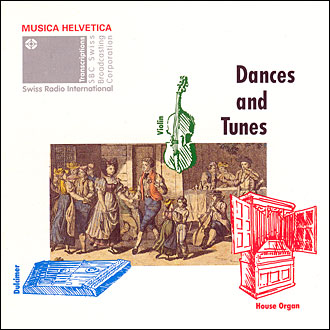Dances and Tunes

A musical rarity from Switzerland. House organist Jürg Neuenschwander, violinist Johannes Utzinger and dulcimer player Christian Schwander perform ancient Swiss dances and tunes. They recreate Switzerland's music culture in the home centuries ago.
Most of the selected music represents relatively unknown compositions, recorded here as they were performed among rural societies of the Emmental (Canton Berne) or the Toggenburg (in the eastern Canton St. Gallen) in the late 19th century. The musical items were clearly in the folk tradition of their time. But they were not so far removed from so-called “serious” music. The composer of the organ pieces, Martin Vogt for example, was a trained classical musician.
Instruments – the violin
The violin needs no introduction as a Swiss folk music instrument. A well preserved instrument from a 16th century farming family is widely considered to have been a forerunner of the violin in this country.
Instruments – the dulcimer
The dulcimer has been a popular folk instrument in Switzerland and other Alpine countries since at least the 16th century. The origin of the dulcimer or “Hackbrett” can be traced back to Arabia. From there the instrument spread in various forms to the Balkans, Spain and the rest of Europe. In Switzerland, an uninterrupted dulcimer tradition exists in the east of the country (Appenzell and Toggenburg) and the Alpine region of the upper Valais. In the Emmental region of canton Bern, the instrument is currently the object of renewed interest.
Instruments – house organs
House organs were particularly popular until the 19th century in the Toggenburg region of eastern Switzerland and in the Emmental. But whereas they were previously to be found in the homes of wealthy urban dwellers, they had by this time become proud possessions of well-to-do farming families.
Handwritten sheets of music from the mid-19th century show that in addition to hymns and psalms, the instrument was widely used to perform dance melodies and other popular compositions. With the increasing popularity of the piano and the harmonium, it became an object of neglect and was finally forced into obscurity.
The house organ heard on this recordings originates from the Emmental and was built in the early 19th century.
An old Swiss dance, called the “Simmentaler”
This melody was noted down in 1556 by Urban Weiss, and was included in a Strasbourg collection. It is one of the oldest examples of Swiss folk music. On this recording the slow first part features a one handed flute, made by performer Johannes Utzinger himself, from an elderberry branch.
Martin Vogt (1781-1854)
Born in Germany, he arrived in Switzerland in 1806 during the Napoleonic wars. He stayed in the country – mainly in Basel and St. Gall – until 1837. The rest of his live he spent in French Colmar as an organist.
Production information
Dances and Tunes. For house organ, violin and dulcimer (1986/1991). Musica Helvetica MH CD 61.2. Produced for SRI by Andreas Lüthi and Patrick Linder.

In compliance with the JTI standards
More: SWI swissinfo.ch certified by the Journalism Trust Initiative

You can find an overview of ongoing debates with our journalists here. Please join us!
If you want to start a conversation about a topic raised in this article or want to report factual errors, email us at english@swissinfo.ch.